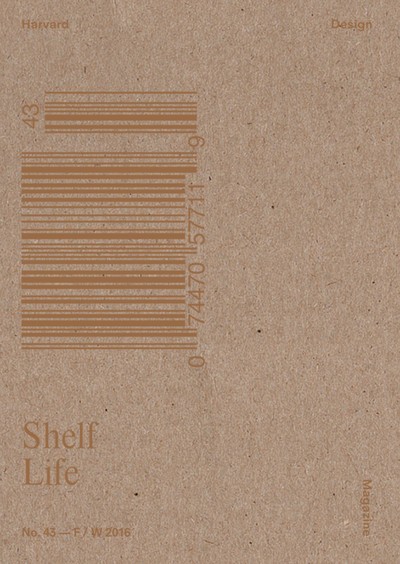Harvard Design Magazine i — January 2017, #43

Harvard Design Magazine
Relaunched in summer 2014, Harvard Design Magazine probes beyond the established design disciplines to enrich and diversify current discourse. Scholarly, poetic, and visually lush, each issue triggers new interpretations of design’s defining role in today’s culture. Distinguished and unexpected voices from the fields of architecture, landscape architecture, and urban planning meet those from the realms of art, science, literature, and beyond. A space for dialogue, speculation, and surprise: Harvard Design Magazine opens a door onto the applied device of design, and the people, places, and politics it engages.
- 404 (26)
- United States
- Two issues a year
- Art, Culture, Design
Harvard Design Magazine #43
The more stuff we accumulate, the more space we need to store it all. Vast portions of the landscape are claimed and governed by spaces of storage, their maintenance, and the goods that move through them—or remain buried within them indefinitely. This issue of Harvard Design Magazine investigates and unpacks the contents, containers, and systems of storage that organize our world. Storage is the aggregation and containment of the material and immaterial stuff of culture; but also the safeguarding—or hoarding—of energy and tools for some imagined future purpose. How does all this stuff mask or overcompensate for economic and ecological bankruptcy? Is storage about greed or need? Storage, perhaps, is everything we can live without but insist on living with. “Shelf Life” explores what’s inside the box (shed, tank, urn, vault, crypt, crate, case, pot, bag, vat, morgue, safe, bin, archive, warehouse, cabinet, cellar, cemetery, depository, locker, freezer, landfill, library). Even as we attempt to reduce and recycle, the stuff that we dispose of also needs to be stored. Where do we put it? Our planet is now a saturated receptacle. This warehouse is full, and we’re all inside it.
Table of Contents
EDITOR’S NOTE
Socks and Stocks Jennifer Sigler
ARTIFACTS
Learning from the Steel Susan Nigra Snyder
Mammoth and Other Frozen Meats Hi’ilei Julia Hobart
A Civic Monument That Never Was Fabrizio Gallanti
Built Like a Skyscraper Craig Robertson
Catching Rain in Singapore Benjamin Leclair-Paquet
Grain Silos Go to India Ateya Khorakiwala
Information Material Jesse LeCavalier
Keeping It Fresh Melissa Cate Christ , Tomas Holderness, Daisy Tam
Marking Toxicity Robb Moss, Peter Galison
Meals, Ready to Throw Away Jesse Connuck Media Clutter Lynn Spigel
Slope to Drain Kate Orff
The Other City Samuel Medina
Trash at the Center of the Theater of the World
DESIGN EARTH
Use in Case of Emergency Only Jacob Lillemose
When Aalto Met Google Rory Hyde
COLUMNS
Crackers, Granite Mountain, and Future Memories Brian Evenson
Cupboard Love Emily King
Repeat Jonathan Olivares
Anxious about Stuff Martti Kalliala
Architecture without Content Kersten Geers
Carry, Conceal, Hide, Suggest, Cover Femke de Vries, Joke Robaard
Formatting the Modern Dream
Anna-Maria Meister
Sant’Eustachio
Barry Yourgrau
The Five Points of Cloud Architecture Antonio Furgiuele
The Temperamental Interior Zeina Koreitem, John May
ESSAYS
Before BILLY: A Brief History of the Bookcase Shannon Mattern
Storage Flows: Logistics as Urban Choreography Clare Lyster
La Esmeralda, and a Brief Interrogation of Prison Ship Memory
Bryan Finoki
Gray Space
Alex O’Briant
Hiding in Plain View Mark Mulligan
Hoarders of Magnitude: Super (and Not-So-Super-) Organisms Kiel Moe
Life in Storage Peggy Kamuf
Notes on More Andrew Holder
Objectives: The Architectural Potentials of Storage Megan Panzano
The Trove: On Vaults, Innards, and the Broad Collection Mimi Zeiger INSERT
In My Possession Maira Kalman
INTERVIEWS
Under the Bed Is a Dark, Cool Place Darra Goldstein, Christina E. Crawford
Designing the Void Anupama Kundoo, Ateya Khorakiwala
Talking Objects Martin Roth, Mohsen Mostafavi
Unité as White Cube Tom Burr, Alex Kitnick
PHOTO ESSAY
Assemblages Armin Linke PLUS
Lager: Two Storage Buildings for Ricola
Jacques Herzog
Cryogenesis
Rhonda Ganz
Fulfillment David Zielnicki
What do you think of this issue?
Sign up or Log in to join the discussion.
Recent activity
- 15 May, 2019 Wanted by JesperBylund
- 05 Jan, 2017 New cover uploaded by Mottobooks
- 05 Jan, 2017 Added to Magpile by Mottobooks




